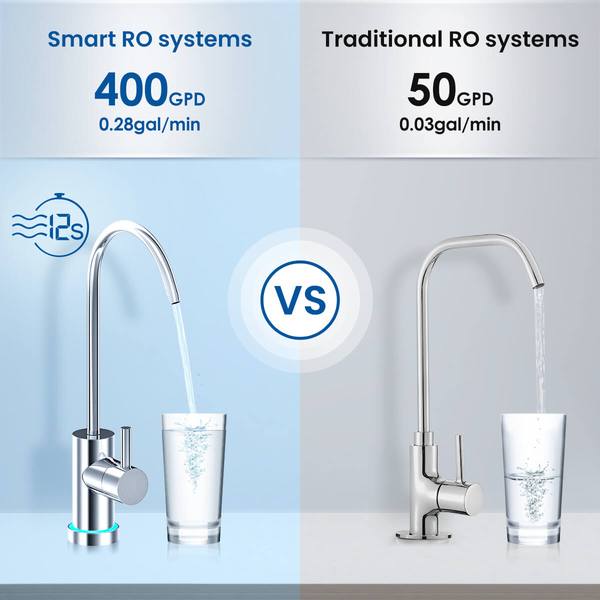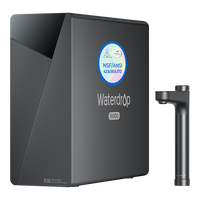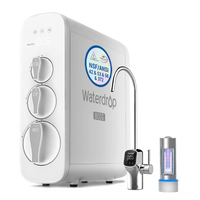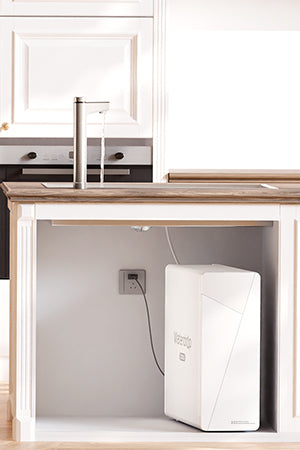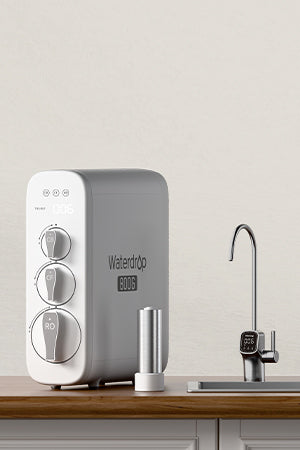Can you tell apart the traditional reverse osmosis system and the tanless reverse osmosis system? What are their differences in terms of flow rate, waste water and so on? Waterdrop will list every detail about it.
Technology is driving a lot of changes in recent times. This puts commercial businesses in a vital position to either follow the trend or be left behind. Talking about following the trend, most businesses are yet to adopt smart design-based reverse osmosis purification systems over the former traditional methods. Why? Because only a few of these companies know about the existence of these better water filtration technologies.
At commercial levels, water purification is now a smoother experience, thanks to these modern, SMART filtration solutions. From the availability to the supply, use, and maintenance, the superiority of the tech-backed commercial water purifiers has relegated the traditional
RO water purification methods to the background.
Against this background, this post will attempt to discuss these two water purification systems at length. We will focus on the capabilities of each, the differences between both, and the advantage of the smart technology-based water purification and monitoring systems over the traditional reverse osmosis system.
The list of the talking points below will guide us through our discussions:
- The purity level of purified water
- Water flow of a reverse osmosis system
- Water tank of a reverse osmosis system
- Waste water of a reverse osmosis system
- Smart design
- Easy installation
The purity level of the purified water
The traditional reverse osmosis system hardly offer concise levels of water purity. Likewise, the pathogen removal process is inefficient and incomplete. The purified water may end up with a bad taste, an unpleasant odor, and tons of pathogens, thanks to the choked RO membranes. Drinking such water causes harm to the
liver,
stomach, and
skin, and may lead to cancer in extreme cases.
Conversely, some
modern reverse osmosis system rely on their advanced filters to find lasting solutions to these problems. For instance, the DOW membrane – a product of the Dow Chemical Company – does a better job in filtering out the harmful pathogens and substances. Its improved performance is partly due to the delicate materials it is made from and the smaller sizes of its pores.
Water flow of a reverse osmosis system
At a 50 GDP capacity and 0.03 gallon/min flow rate, the standards offered by the traditional RO systems are clearly not enough in today's world. An average family will need something more to meet their daily water needs. This used to be a significant problem until the advent of the modern RO systems.
Known for their large capacity and advanced functions, the modern tankless RO water filter systems are fast becoming the new norm in the market. For instance, an average modern system has a capacity of 400 GPD – 4x the capacity of the traditional systems. They also come with multi-layered filters instead of the single-layered versions in the older systems. This gives the water purifier more routes and, ultimately, improved filtration capability.
For comparison purposes, you can expect a purification system of
400 GPD to fill up a 0.28 gallon water container every minute. This is an excellent performance both in commercial and household standards.
Water tank of a reverse osmosis system
The water storage tank is typical to all traditional reverse osmosis system – it houses the filtered water until the user gets them via the
pressure pulp. This is why the process is somewhat faster – it takes just 20 seconds to fill a cup.
That said, the water tanks in traditional water purifiers are flawed. For instance, they can facilitate the growth of bacteria, except they are regularly flushed and cleaned. This would not be a problem if the cleaning process were not expensive. Likewise, the container smells rubber, which comes from the rubber that separates air and water. This, sometimes, gives the filtered water a foul odor.
The new generation of RO systems running on an advanced smart tech removes these limitations. They do not only offer more purified water, but they do so without needing a storage tank. The elimination of the tank also eliminates the issues of bacteria and impurities. This makes them the safe source of pure, contaminant-free drinking water at all times.
For comparison purposes, let's take a look at the water flow, dimension, taste and purity capabilities of tankless purification systems and those with a tank.
Water wastage of a reverse osmosis system
The different
TDS levels in the traditional purification systems are responsible for the avoidable water wastage. These older plants rely on the RO technology at all times, even when it is unfit for the type of water being filtered. This is evident in its wastewater-water ratio, which is 1:3(three cups of waste water).
This is not the case in modern purification systems, thanks to its more efficient filters. The average wastewater ratio is either 1:1 or 1.5:1 in most cases. Therefore, these systems are more efficient and will prevent unnecessary water loss.
Smart design
After about a decade without an intelligent function, modern reverse osmosis water purifier now offers more convenience to users by leveraging smart technology. Commercial pure water requirements are conveniently met using these technology-backed purifiers. They do offer not only high purity levels but also 24/7 life monitoring and real-time feedback, as well as a TDS display for easy accessibility. But the best part is that you can be sure of an uninterrupted supply of clean, purified drinking water at any time of the day.
Easy installation
The last talking point on our list is installation – another aspect where the modern RO purification systems excel. A simple installation process compliments their intelligent design.
You will expend hours and serious efforts into the installation of traditional RO systems if you are not spending extra to hire a professional plumber. This has always been a problem for users who are neither mechanical nor handy.
Modern RO systems, on the other hand, have no complicated tanks and composite filters. Therefore, the installation is a simple DIY and can be completed in half an hour. The best part? Most of these systems come with an easy-to-follow installation manual that can guide you.
Conclusion
Our discussions so far clearly highlight the need for innovation in the water purification industry. And this is what the smart, modern RO water filtration system are bringing to the table. At Waterdrop, we are championing this movement by investing our time, efforts, and capital into improving water purification systems.
We are committed to providing better and newer functions that improve the experience of the user. You can Learn more about our excellent ideas – our products and services – by clicking
here.
